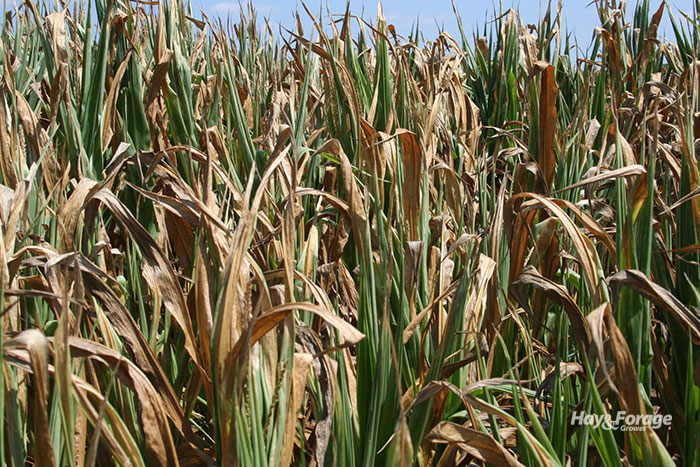
Corn that has been stunted by a lack of rainfall brings some unique challenges for silage harvest.
Dairy nutritionist Bill Wiess states in a recent issue of The Ohio State University Extension’s C.O.R.N. newsletter, “The primary goal of making corn silage is to preserve as many nutrients in the corn plant as possible, to produce a feed that is acceptable to cows, and to minimize any risks associated with feeding the silage.”
Field conditions are a major factor to consider when harvesting corn for silage. When it comes to the plant itself, dry matter and nitrate concentration are two key components of producing safe, high-quality corn silage. Both can be difficult to assess in drought-stressed corn.
Assess dry matter
Drought-stressed corn plants are often much wetter than they appear. Even though the lower parts of the plants look brown and dried out, the moisture level can still be too high for proper fermentation, according to Wiess. He suggests collecting and analyzing samples for accurate moisture levels. Use a Koster tester, microwave, or commercial lab to analyze dry matter (DM) in samples.
Elevated nitrates
Drought-stressed corn plants can accumulate nitrates that can be toxic to ruminants. Wiess advises that silage from drought-stressed fields be tested before it is fed.
“Ideally, corn plants should be sampled and assayed for nitrates prior to chopping; most labs offer very rapid turnaround times for a nitrate assay,” the nutritionist noted. “If values are high, raising the cutting height will reduce nitrate concentrations in the silage because the bottom of the stalk usually has the highest nitrate concentrations. Nitrate concentrations are reduced during silage fermentation. High nitrates in fresh corn plants may end up as acceptable concentrations in the fermented corn silage,” Wiess added.
Silage with more than 1.5% nitrate (0.35% nitrate-N) has a high risk of causing nitrate toxicity in cattle
Consider a buchneri inoculant
After field conditions are met for high-quality corn silage, the next steps are to harvest and store the corn. Wiess explained, “When silage is worth upwards of $80 per ton at 35% dry matter, reducing shrink by 2 percentage units has a value of about $2 per ton.” Using a proven inoculant could save spoilage and quality values down the line. He continued, “Homolactic inoculants are the standard silage inoculants and produce lactic acid, which reduces fermentation losses but sometimes can increase spoilage during feedout. The buchneri inoculants increase acetic acid, which slightly increases fermentation losses but greatly reduces spoilage during feedout.”
Drought-stressed silage can have high concentrations of sugars because less starch is deposited in the kernel. These sugars provide a food source for undesirable yeasts and molds. Wiess recommends using a research-proven buchneri inoculant to inhibit yeast and mold growth and extend the aerobic stability of drought-stressed corn silage.
Not too fine
Wiess warns not to chop too finely, or the effective fiber concentration of corn silage may be reduced. “Generally, a theoretical length of cut (TLC) of about ½ inch is acceptable, longer with kernel processing and brown midrib (BMR) silage, but this varies greatly between choppers and crop moisture concentration,” he explained.
Using a kernel processor can have many benefits, especially for drought-stricken corn silage. First, kernel processing will enhance starch digestibility by breaking the kernel. Poor starch digestibility is a major problem with dry, mature corn silage. Processed corn silage also tends to pack more densely than unprocessed silage, which may help lengthen aerobic stability.
Practicing good silage-making techniques such as filling the silo quickly, packing adequately, and then covering and sealing the silo as soon as possible can reduce shrink by more than 5 percentage units. “This can be worth more than $4 per ton of 35% dry matter corn silage,” Wiess concludes.

C.J. Weddle served as the 2020 Hay & Forage Grower editorial intern. She currently attends Mississippi State University, majoring in agricultural education, leadership, and communications. She grew up on a farm in Vardaman, Miss., where her family raises sweet potatoes and soybeans.

